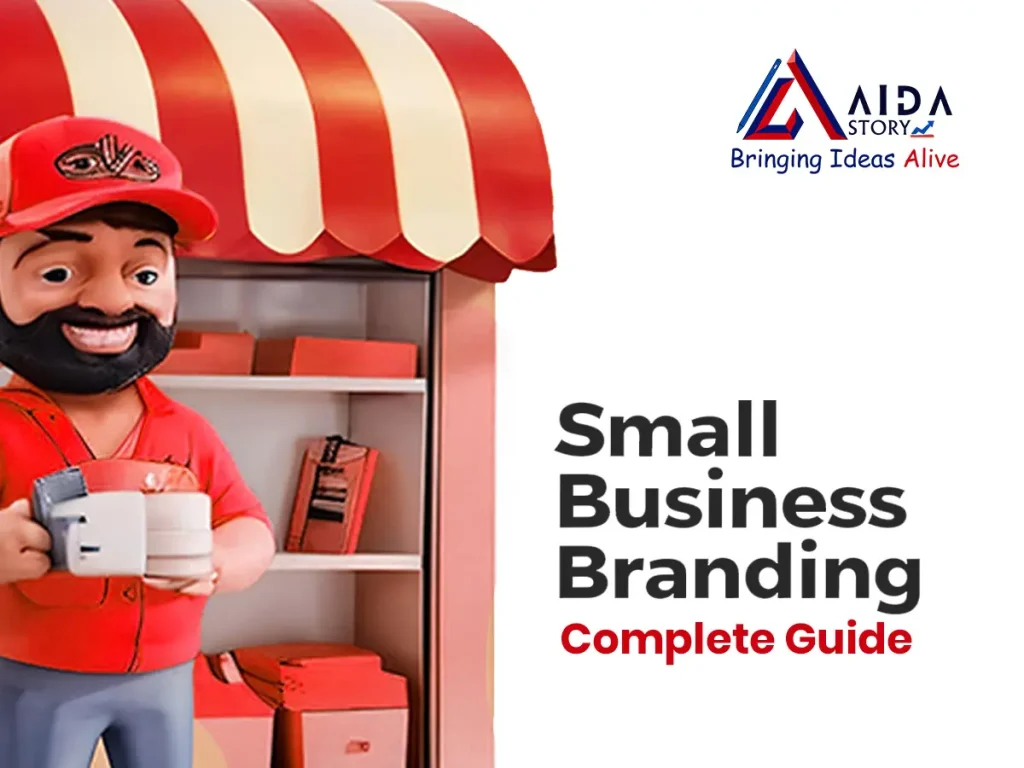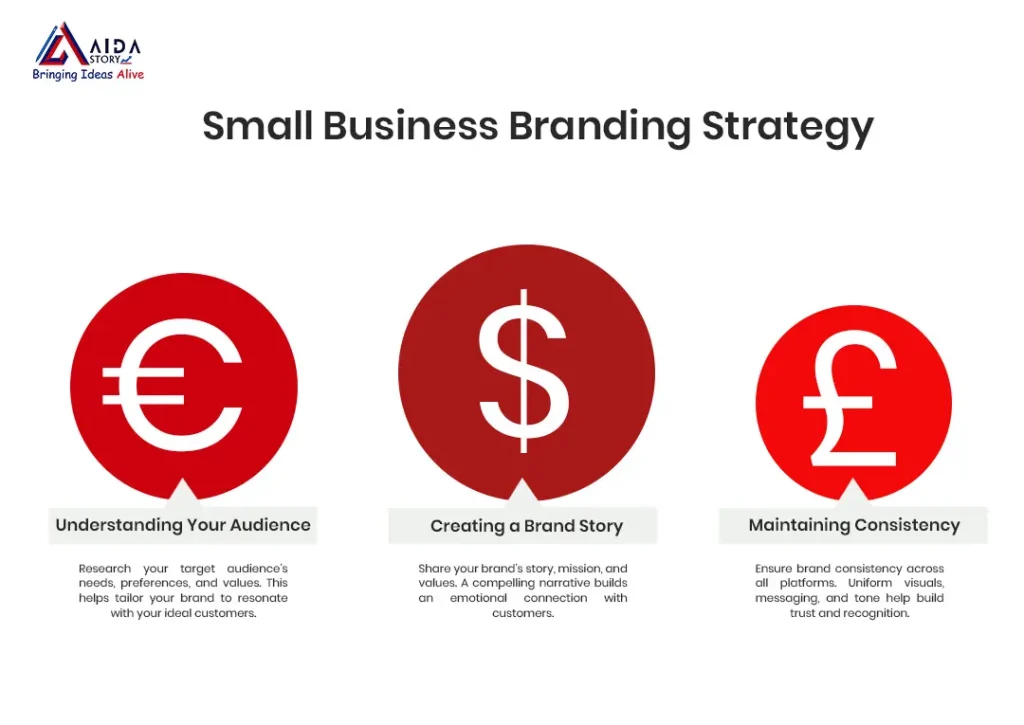
In today’s market, small business branding is not enough just to have a slogan and a logo; it is about making that image familiar and noteworthy. Brand identity helps differentiate a business, build customer loyalty, and ensure that the business grows.
Small businesses can, therefore, use branding to foster a personal relationship with consumers that very large companies cannot.
Our branding information concerns foundational knowledge, recommendations, and how a branding expert can assist you in developing the idea of your brand.
How and Why Small Business Branding Matters
Branding is not just about the color of your company’s products or the logo you choose; it is at the core of your customer’s interactions with the company. Influence for small businesses is significant, as no one wants to be just another name in the crowd.
Highly relevant and genuine brands are easy to associate themselves with, especially with small businesses.

A well-defined brand identity accomplishes several key objectives:
Increases Recognition: When customers are given a coherent image, color, or message of your brand, they will likely retain the brand in their memory.
Builds Trust and Credibility: The high level of continuity makes the brand look professional, making customers feel they can trust you.
Encourages Loyalty: A repeat and referral business directly results from people supporting companies they relate to.
Small business markets can be very selective and do not share the broad appeal of a large business. This is quite a blessing for creating brand loyalty because you can now create a brand image near and dear to sure customers.
For instance, a bakery in a neighborhood can center its adverts around aspects such as friendliness and being part of people’s daily lives. On the other hand, an online boutique may use ad messages that center on quality service for its desired clientele.
Read this article on building a strong brand image for your small business.
Key Elements in Branding Small Businesses
The branding process is as follows: one has to concentrate on several key factors that shape a particular image, which are elaborated on below.

1. Logo and Visual Identity
In my opinion, your logo is one of those images that a customer is first likely to relate to your business.
It should be unique and attractive and reflect your brand’s ethos. A logo and proper color strategy help make your business conspicuous and easily recognizable.
Small businesses generally require clean, easily adaptable designs for simple things like business cards and web designs.
All the colors used, any fonts or other graphical elements, should be in harmony so that they support your brand.
For instance, the colors of the firm offering consultancy or any corporate advisory service would perhaps opt for the corporate colors of a professional-looking firm or office.
2. Brand Voice and Messaging
The brand voice accurately represents the manner in which a business communicates, and that is why it is a big part of your brand.
Your voice should be consistent throughout all your social networks, your website, and your print materials. Consumers will feel relaxed using your brand if the tone adopted is humorous.
On the other hand, the more serious kind of language appears appropriate for professional service-related advertisements.
Having a precise brand personality facilitates customers’ personal connections with your business.
By establishing the right perception, you are actually showing them your beliefs and attitudes, making them familiar with your brand.
3. Customer Experience
Any visit to your homepage, phone call, chat with the support service, and much more determines the customer’s perception of your brand.
The kind of experience that one has paints a good picture, but conversely, the bad experience paints a very ugly picture.
This requires that if you want the buyer to have a harmonious experience, your website should have a good structure and flow, whoever contacted customer service should get satisfactory information and answers.
The product or service that solves the consumer’s problem should provide a solution to the problem the consumer had initially.
If your business is from healing motels to massage services, your site and conversation should be free from aggressive designs and vocabulary.
4. Values and Mission
Brand values and mission provide functions from which the purpose and direction of your business can be determined.
When you state and show these values publicly, your business attracts a crowd of people who respect and embrace them, which increases customer loyalty.
For example, if consumers’ well-being or fair trade are among the values, such a brand might use environmentally friendly packing, sourcing, and communication of proper policies on customer welfare.
Expressing one’s values is the key to building trust. Clients are assured that the money they spend is on something they fully endorse. Values may also play a part in writing the brand story, giving customers a purpose in selecting your business.
For more practical examples of good branding, please view these examples of small business branding.
The Tips on Branding for Small Businesses
That’s why brand creation is a continuous process, no less effective and precise, requiring consistent work and detailed knowledge of the audience. Here are some aspects you need to consider for branding your business as a small business to assist you in creating an excellent brand.

1. Know Your Audience
Implicitly, you must know your audience — or rather, what they want and what defines their vision of a perfect brand.
Polls on surveys, live chats on social media, and getting your clients’ feedback can help determine what clients desire from your company.
The audience’s insight makes it possible to make much more desirable decisions, especially about the people being served.
For example, if your target group is green, there is a hint that labeling your products as environmentally friendly or packing them that way will help attract more attention to them.
Using values in congruence with their own improves their relationship with their brand.
2. A Guide to Building a Great Brand Narrative
This makes the act of telling one good story the foundation for building relationships. Where did your business start, what problems did you face, and what are your goals? The idea is that when you tell a great brand story, your branded product becomes more familiar to consumers.
For instance, if your brand story is about sourcing locally, or supporting various causes within a region or country, make this public. An authentic story can foster people’s engagement, making the customers care more about your company.
3. Ensure That All Your Platforms Stick To A Single Consistent Brand Image
If one aims for clients to remember a business, it is crucial to be bonded within the same strategic pattern.
Ensure you keep your logo brand tone and message consistent across websites, social networks, and print marketing materials.
Misinformation may create confusion for customers while diluting the effects of your brand.
For instance, if your Instagram profile has a laid-back approach where you are friendly with your words, but your website is rather stodgy and formal, customers will have difficulty making sense of your brand.
Regular branding builds up your concept and makes customers build up strong impressions of your business.
4. Purchase professional quality visuals
Graphics and images have become central in branding because they influence how customers view products. Perfectly done visuals promote professionalism and reliability, whether for portfolio pictures or posts and threads on social media.
Maintaining a consistent visual style and language as your brand is also essential. For example, if wellness is chosen, the palette and graphics will differ significantly from those selected for a children’s brand.
Articulating quality visions in all touched beta items demonstrates to customers that your business entity is still focused on quality, which strengthens customers’ trust in your business entity.
5. Engage with Your Audience
It must be understood that engagement is a significant aspect of branding. Use social networks to communicate with your target audience and react to their feedback. Demonstrating to your audience that you are listening and will respond creates a following of brand advocates.
As we discussed, engagement allows you to get to know more about the people you are targeting and the kind of messages they appreciate.
Customers are always willing to spend their hard-earned money when they feel they are being listened to and when you show them love.
6. Maintain Brand Integrity
Your brand values should be bare and seen in your business’s operations. If sustainability is one of your values, then this should come across in your products, their packaging, and all your promotional collaterals.
Consumers respond to honesty, and developing and maintaining a company’s integrity establishes the market and the clientèle.
Being consistent in values helps retain customers and eases their concerns about your brand.
To learn more branding tips, read these 10 great examples of small business branding.
Small business branding consultant
Any small business person will agree with me that the process of building brand consistency cannot be easy. This is where a branding consultant comes in handy, mainly if you operate an online business.
Employing the services of a consultant means that you get to access professional advice, an impartial view, and organization, all of which aid in creating your professional brand identity that is appealing to the intended audience.
Pro Services helps in all rebranding phases, including values, logos, color preferences, and even more refined messages. This professionalism is handy for branding since it frees time to concentrate on the business.
Benefits of Hiring a Branding Consultant:
Professional Insights: Professional help is valuable for understanding the current keys to branding and building a company’s proper image.
Time and Resource Efficiency: Branding consumes time; where possible, a consultant can take up some crucial activities for you.
Unbiased Perspective: What you may fail to see or think about, consultants have an opportunity to see and challenge you.
Consultant services are usually worth hiring if the small business wants to create a unique brand image.
Conclusion
Small business branding is crucial in establishing market differentiation, credibility, and customer loyalty in a cut-throat world. Through proper and consistent use of visuals and the acquisition of a strong voice and a brand story, it is possible to create a brand that will make a positive audience association and grow the brand.
These tips guide beginners and show how to develop a brand further for those who already have one fully set up. If you seek further assistance, hiring a branding consultant to help fashion your branding strategy is wise.
To get more information and ideas on branding and marketing for your small business, visit the AIDA Story website at aidastory.com.
FAQ Section
What is small business branding?
Small business branding is relevant because it creates credibility with the target consumers, increases the company’s customer base, and differentiates the company from its competitors.
What are the factors that define branding for small businesses?
These are things such as the logo, which should be unique, the tone of voice of the brand and Mustache images, and the overall experience of the brand, which must support the brand’s values.
What is advised to small businesses when it comes to branding?
Some of the best practices are understanding the viewers, creating a company’s narrative, consistency, and interaction.
What can a branding consultant do for this small business?
Hiring a branding consultant means professional help in developing your brand and its strategies. It takes less time than doing it on your own, and the quality of the brand would be considerably higher.
How can a brand be easily memorable to small businesses?
Brand essence is characterized by consistency in verbal and nonverbal communication.



